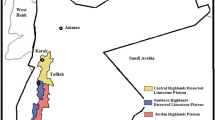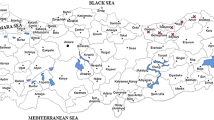Abstract
Radiation safetry criteria adopted in Russia (in the former USSR) distinguish five classes of tritium compounds. The lowest permissible tritium concentration in the air is set for insoluble tritium compounds (3.105 times lower than that for HT). Russia's criteria for tritiated radioactive waste are outlined. It is explained why the tritium weighting factor of two is used as a basis for the tritium dose criteria development in this country. The ecological situation nearby a large tritium processing plant is considered. Amounts of tritiated waste produced at the plant, sources of tritium effluents, tritium content in the air, water, snow, soil and vegetation as well as HTO sorption parameters of various food products are reported. On the basis of HTO near-surface concentrations in the air and public doses measured 3 km away from the plant stack, the tritium dose factor was calculated.
Similar content being viewed by others
References
International Commission on Radiological Protection, 1990 Recommendations of the International Commission on Radiological Protection, ICRP Publication 60, Annals of the ICRP, 21, 1–2, Pergamon Press, 1991.
Codes of Radiation Safety (NRB-76/87); Basic Health Protection Rules for Work with Radioactive Materials and Sources of Ionizing Irradiation (OP-72/87), Moscow, Energoatomizdat, 1988 (in Russian).
M. I. Balloon, I. A. Lighter, and X. I. Moskalev (1984). New radiation safety codes for tritium compounds.Atomic Energy,56(2), 94–98 (in Russian).
M. I. Balonov (1983). Dosimetry and standardization of tritium, Moscow.Energoatomizdat (in Russian).
International Commission on Radiological Protection, Radionuclide Limit of Intake for People Working with Ionizing Irradiation, ICRP Publication 30, Moscow, Energoizdat, 1982 (in Russian).
A. Benco and G. A. Vivian (1993). Fusion Energy: An Emerging Practice, OECD Nuclear Energy Workshop on Radiation Protection Toward the Turn of the Century, Paris, France, January 11–13.
IAEA, ITER Safety, ITER Documentation Series, No. 36, IAEA, Vienna, 1991.
J. Raederet al. (1988). Safety and Environment for ITER-Specialists Meeting-Record and Conclusions, ITER-TN-SA-8-3, August 19.
Yu. M. Stuckenberg (1991). About relative biological effectiveness of tritium oxide.Problems of Atomic Science and Engineering (series Thermonuclear Fusion)1991(3), 9–18.
L. F. Belovodskij, V. K. Gajevoj, V. I. Grishmanovskijet al. Radioecological aspects of tritium processing,Problems of Atomic Science and Engineering (series Thermonuclear Fusion)1993 (1–2) (in Russian) (to be published).
L. F. Belovodskij, V. K. Gajevoj, and V. I. Grishmanovskij (1985). Tritium. Moscow, Energoatomizdat (in Russian).
Basic Safety Standards: International Standards for Protection against Ionizing Radiation and for the Safety of Radiation Sources (draft), jointly sponsored by the Food and Agriculture Organization of the United Nations, the International Atomic Energy Agency, the International Labor Organisation, the Nuclear Energy Agency of OWED, the Pan American Health Organization and the World Health Organization.
Rights and permissions
About this article
Cite this article
Kolbasov, B.N. Tritium dose criteria and radiological impact of a tritium plant. J Fusion Energ 12, 121–126 (1993). https://doi.org/10.1007/BF01059366
Issue Date:
DOI: https://doi.org/10.1007/BF01059366




